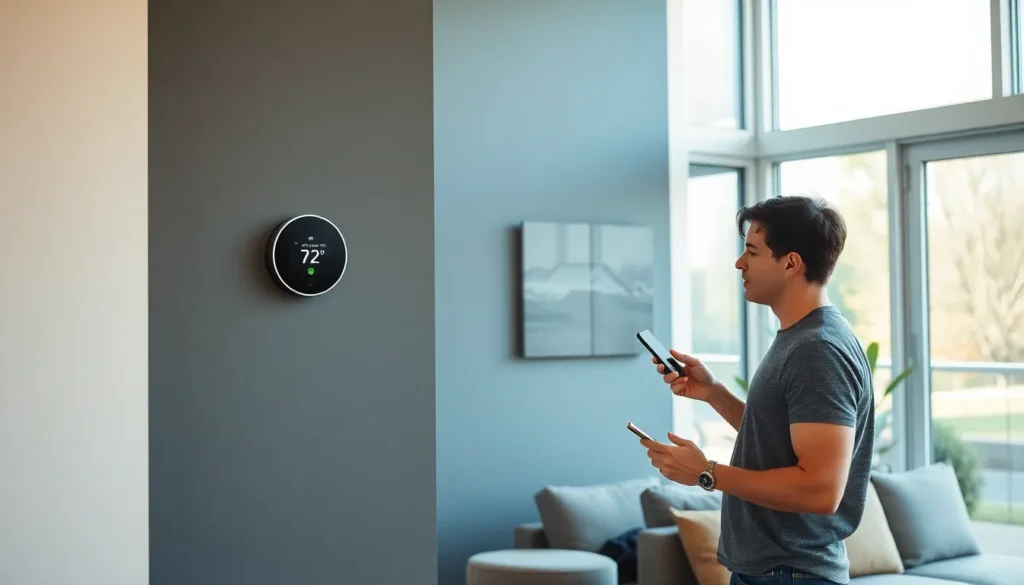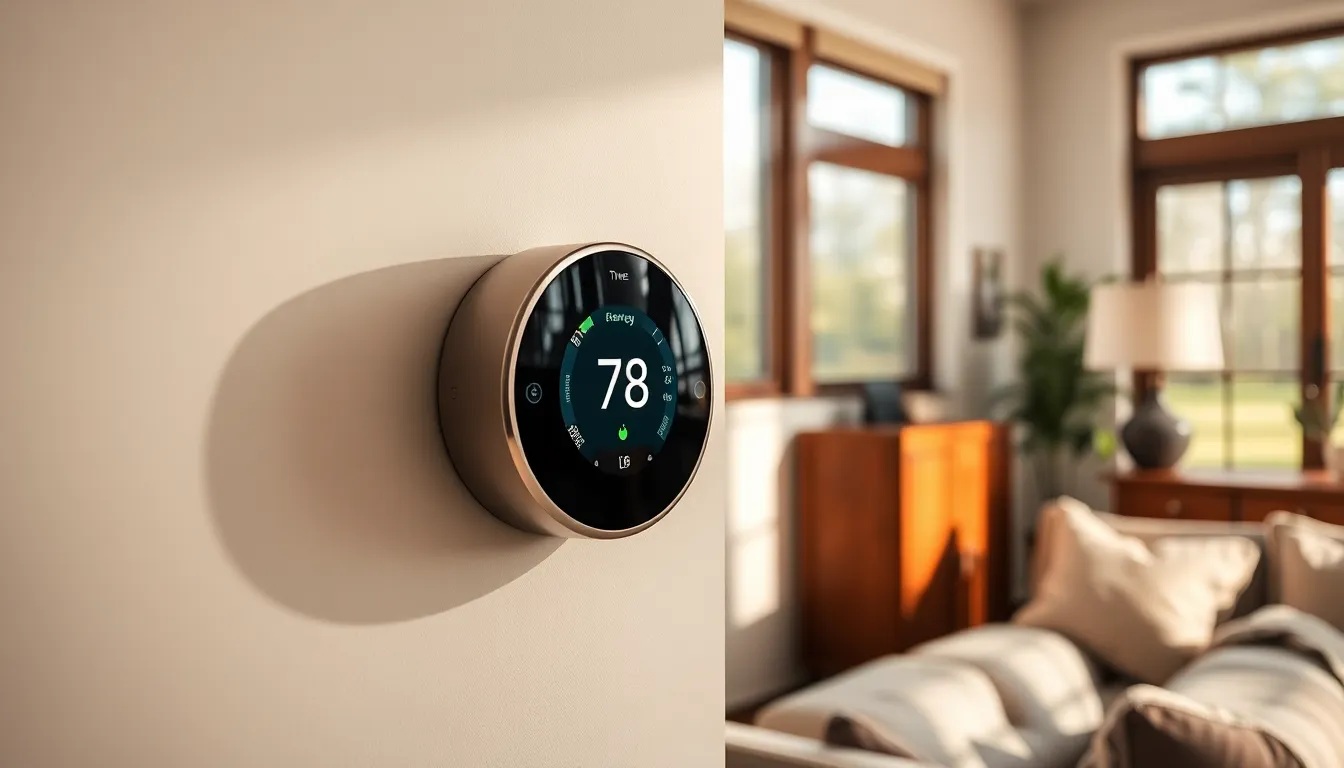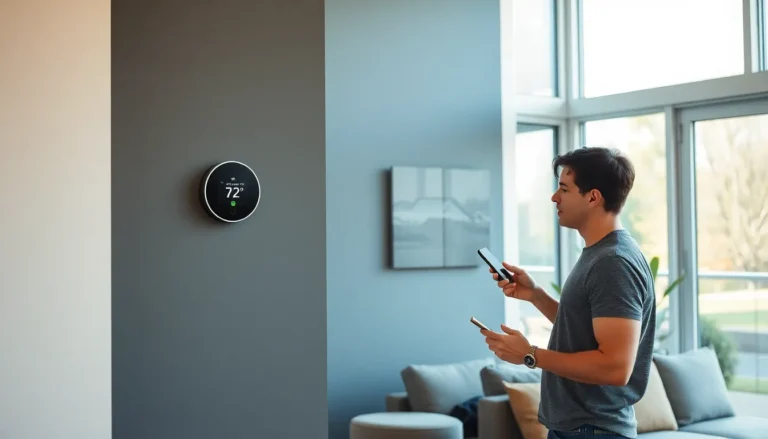Table of Contents
ToggleIn a world where even your coffee maker can connect to the internet, why should your thermostat be left out of the fun? Enter the smart thermostat, the brainy gadget that not only keeps your home cozy but also saves you a pretty penny on energy bills. Imagine a device that learns your schedule, adjusts temperatures while you’re away, and even lets you control your home’s climate from your phone—talk about a win-win!
Gone are the days of wrestling with complicated dials and buttons. With a smart thermostat, it’s like having a personal assistant for your heating and cooling needs. Plus, it’s eco-friendly, which means you’ll be saving the planet while you’re at it. So, if you’re ready to embrace the future and make your home smarter, this little device might just be your new best friend.
Overview of Smart Thermostats
Smart thermostats represent a significant advancement in home heating and cooling technology. These devices integrate with Wi-Fi networks, allowing users to control their home’s temperature from anywhere using a smartphone. Learning algorithms enable smart thermostats to adapt to individual schedules, optimizing energy use effectively.
Known for their energy-saving characteristics, smart thermostats can reduce heating and cooling costs by up to 30%. A study by the U.S. Department of Energy highlights this potential for savings, which greatly appeals to budget-conscious consumers. Additionally, many devices provide usage reports, giving users insights into their energy consumption patterns.
Environmental benefits play a crucial role in the allure of smart thermostats. By optimizing energy efficiency, they contribute to lower greenhouse gas emissions. Studies show that wide adoption of these devices can significantly impact energy sustainability goals.
Smart thermostats often feature compatibility with various smart home systems, enhancing their functionality. For instance, integration with home assistants allows users to adjust settings using voice commands. This seamless integration complements user convenience tremendously.
Multiple models exist, each with unique features tailored to different needs. Some offer geofencing capabilities, enabling the thermostat to adjust the temperature based on the user’s location. Others come equipped with air quality monitors, alerting users about their home’s environmental conditions.
Smart thermostats merge technology, energy efficiency, and convenience into a single solution. These devices not only enhance comfort but also align with modern sustainability efforts, making them an essential addition to any home.
Benefits of Using Smart Thermostats
Smart thermostats provide various advantages that enhance comfort and lower energy costs. Their intelligent features and ease of use improve efficiency across the board.
Energy Efficiency
Energy efficiency becomes a priority for homeowners using smart thermostats. These devices learn user habits and preferences, adjusting temperatures automatically based on real-time data. Data from the U.S. Department of Energy supports claims that smart thermostats can reduce energy consumption by up to 30%. By optimizing heating and cooling schedules, they minimize energy waste, ensuring homes maintain a comfortable environment while consuming less power. Integration with HVAC systems further enhances performance, making adjustments as needed. Smart devices also utilize sensors to monitor occupancy, preventing unnecessary energy use when spaces are empty.
Cost Savings
Cost savings represent a significant benefit of implementing smart thermostats. Homeowners experience reduced utility bills due to lower energy consumption associated with these devices. Many models feature budgeting tools and insights that track energy usage, allowing people to adjust habits accordingly. Enhanced scheduling capabilities provide precise temperature control, leading to further savings over time. Studies demonstrate that families can save hundreds of dollars annually by utilizing these technologies effectively. With remote access, individuals can also manage their heating and cooling when away, keeping bills low by preventing unnecessary temperature adjustments.
Features of Smart Thermostats
Smart thermostats offer a range of features that enhance user experience and energy management. Each feature contributes to comfort, efficiency, and convenience.
Wi-Fi Connectivity
Wi-Fi connectivity allows smart thermostats to connect to the internet. This connection enables homeowners to control their device remotely using smartphones or tablets. With an app, users can adjust settings, monitor energy use, and receive alerts about system performance. Many models integrate with weather forecasts, adjusting temperatures based on changing conditions. According to the U.S. Department of Energy, this capability can lead to energy savings of up to 30%.
Compatibility with Smart Homes
Compatibility with smart home systems enhances functionality. Users can integrate smart thermostats with devices like smart speakers and security systems for seamless operation. Voice commands through assistants like Amazon Alexa or Google Assistant simplify temperature adjustments. Smart home systems also enable features like geofencing, which automatically adjusts temperatures based on user location. This integration helps create a cohesive smart home environment, optimizing both comfort and energy efficiency.
Popular Smart Thermostat Brands
Leading brands in the smart thermostat market offer innovative features and benefits to improve home energy management.
Nest
Nest, a Google company, sets a high standard for smart thermostats with its sleek design and advanced learning algorithms. Homeowners appreciate how it adjusts temperatures based on user habits. Compatibility with other smart home devices enhances its functionality. The device features an intuitive interface that provides easy temperature control. Energy reports help users monitor usage patterns, potentially leading to significant savings. Nest thermostats can save up to 10-12% on heating bills and about 15% on cooling bills annually. Users can manage their thermostat remotely through the Nest app, elevating their control over home comfort.
Ecobee
Ecobee thrives in the smart thermostat sector by integrating robust technology and user-friendly features. It’s particularly noted for its remote sensor capability, enabling temperature management in multiple rooms. Models like the Ecobee SmartThermostat with Voice Control come equipped with a built-in Alexa-enabled speaker. Energy-saving features make Ecobee appealing, with a potential reduction in energy bills by up to 26% annually. The device’s user-friendly app provides real-time insights into energy usage, helping users adjust their habits. Additional smart home compatibility allows seamless integration with platforms like Apple HomeKit and Samsung SmartThings.
Conclusion
Smart thermostats are revolutionizing how homeowners manage their heating and cooling systems. By combining advanced technology with user-friendly features they not only enhance comfort but also contribute to significant energy savings. Their ability to learn user preferences and adapt to real-time conditions makes them invaluable for modern households.
As energy efficiency becomes increasingly important smart thermostats play a crucial role in reducing utility bills and minimizing environmental impact. With options from leading brands like Nest and Ecobee homeowners can find a model that fits their needs while enjoying the benefits of smart home integration. Embracing this technology is a step towards a more sustainable and cost-effective future.








